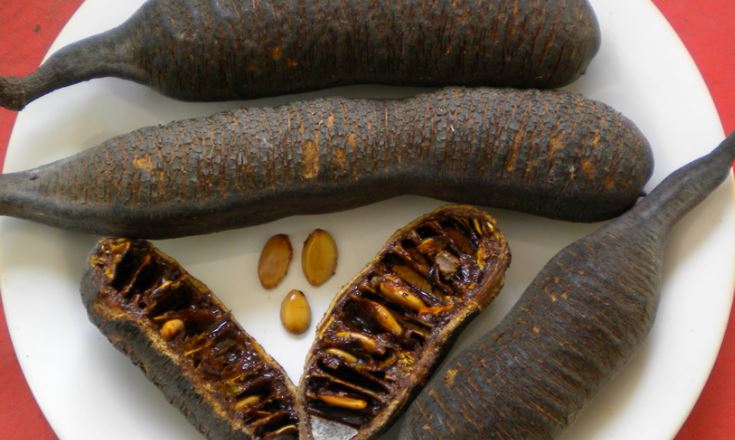Corel shower tree or Cassia grandis is a plant with pink flowers, it is also known as horse cassia. It is a medium-sized, semi-deciduous plant belonging to the Fabaceae/Leguminosae (Pea family). This plant originally came from a large area, stretching from Mexico to Brazil. It is also found on the shores of South American goods and a number of areas in the Caribbean islands such as Cuba, Puerto Rico and Hispaniola.
In their native areas, carao or pink shower plants grow well in dry forests along river banks, and in places prone to flooding. Besides being known as carao and cassia grandis, he also has several other names such as Appleblossom cassia, Horse cassia, Coral shower, Pink shower, Stinking toe, Pink shower tree, Brazilian Cassia, Pink Coral Shower, Liquorice Tree, capote, Nguzat-gyi. , Monkey molasses, O moi, Cassie Grandis, Sandal, Canafistula, stinking toa, Carao, Sandal, Kotek mamak, Kalaa-phruek, Ngu-padamya, Trembalo-wang-wang, and Pink shower.
The name “Cassia” comes from the word “Hebrew” which is “quetsi’oth” and was first used by Dioscorides, he was a physician in Ancient Greece (40–90 AD). The species name grandis comes from the Latin word “large, powerful, showy, or big”. This refers to the size and height of this cassia plant. Meanwhile the name “pink shower” is derived from its bright pink flowers. There are also those who call it the “stinking tree” because the pulp has a very strong aroma. This plant is not only a decoration and beauty with its pink flowers, but it is used by the local people as a traditional medicine. Along the Pacific lowlands, it is a very beautiful plant when in bloom. the beauty of the flowers, making many people adopt it as an ornamental plant.
Plant Description
Carao is a medium-sized fall and spring-autumn plant and grows to about 15-25 (30) m tall, with straight, cylindrical stems 60 cm in diameter. It grows in the wild as an old plant, but provides its own special beauty when it blooms on hillsides and river banks, along roads and in undergrowth.
This tree grows tall with many branches and dangles down to form like an umbrella and is very good to be used as a house canopy naturally. The skin is gray and smooth.
Also see: Health Benefits of Virginia Snakeroot
Leaves
The leaves are compound like the leaves of a tamarind tree and are pinnate with a length of 6–15 inches. The small leaves are arranged alternately in pairs, with about 10 to 18 tiny leaves per stalk. The upper leaves are green and the underside is slightly reddish.
Flower
Coral pink flower is a plant with beautiful pink flowers and this is one of the charms of the carao plant. This is also the reason why many people plant it even by the side of the road even though it is widely planted to provide shade and beautiful flowers in the spring.
The flowers are 3 cm in size and have five large petals. At first the flowers are red and over time they turn faded and pink. The flowers of the carao plant begin to bloom from February to April. However, in some places, the flowers bloom from spring to summer.
Fruit
When the flowers bloom, it is followed by the emergence of pods. The fruit is like a wooden capsule measuring 50 cm (20 in) in length and there are many seeds like a petai fruit which are protected by a hard skin. Each pod has about 70-80 seeds in it. Carao fruit is initially green but then turns black or dark brown when ripe. This fruit contains a sticky liquid that smells when it falls to the ground and breaks.
Health benefits and use of carao
- The fruit is bitter and used as a laxative, it is similar to C. fistula and is even said to be stronger than it.
- If you drink it with milk, it is said to fight anemia and can increase iron in the blood.
- The ripe fruit and seeds are also used as a natural laxative.
- The fresh juice from the leaves of the carao is used externally as a remedy for ringworm.
- Carao is also used as a medicine to increase appetite and gain weight in thin children.
- The decoction of the root of the carao plant is useful for cleaning wounds and treating ulcers
- In the Philippines, the leaves are used as an anti-fungal medicine
- In India, the root of the plant is used to treat fever
Culinary Uses
Carao pulp has a fleshy taste similar to carob (Ceratonia siliqua) or a mixture of chocolate and cherries. It is used in Latin America for fruit drinks.
The pulp is boiled with milk or water and then cooled and sweetened, this is usually used as a delicious dish for young children.
Also read: Jute Leaves Facts and Health Benefits
Other Facts of Carao
- Seeds are sources of gums that have commercial value
- Seed gum is useful in the pharmaceutical industry
- The wood ash is used in the pharmaceutical industry
- The wood is brownish yellow in color, a little hard and heavy and rough and has a rough texture and does not last long.
- Hefty wood is at its advantage in the building industry
- Used as a fence post
- Wood that grows quickly can be used as seeds to build forests
- Cows often eat the pods from trees.
